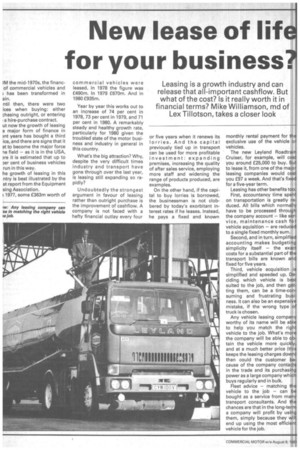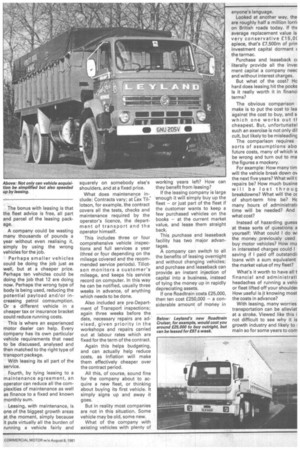New lease of lif for your business
Page 26

Page 27

If you've noticed an error in this article please click here to report it so we can fix it.
Leasing is a growth industry and can release that all-important cashflow. But what of the cost? Is it really worth it in financial terms? Mike Williamson, md of Lex Tillotson, takes a closer look
MA the mid-1970s, the financof commercial vehicles and ; has been transformed in am.
ntil then, there were two ices when buying: either hasing outright, or entering a hire-purchase contract.
ut now the growth of leasing a major form of finance in .1nt years has bought a third ice, and there are signs that it at to become the major force le field — as it is in the USA, 3 re it is estimated that up to )er cent of business vehicles run in this way.
he growth of leasing in this ntry is best illustrated by the st report from the Equipment sing Association.
I 1977, some £363m worth of commercial vehicles were leased. In 1978 the figure was £490m. In 1979 £670m. And in 1980 £935m.
Year by year this works out to an increase of 74 per cent in 1978, 73 per cent in 1979, and 71 per cent in 1980. A remarkably steady and healthy growth rate, particularly for 1980 given the troubled state of the motor business and industry in general in this country.
What's the big attraction? Why, despite the very difficult times industry and transport have gone through over the last year, is leasing still expanding so rapidly?
Undoubtedly the strongest argument in favour of leasing rather than outright purchase is the improvement of cashflow. A company is not faced with a hefty financial outlay every four or five years when it renews its lorries. And the capital previously tied up in transport can be used for more profitable investment: expanding premises, increasing the quality of after sales service, employing more staff and widening the range of products produced, are examples.
On the other hand, if the capital to buy lorries is borrowed, the businessman is not clobbered by today's exorbitant interest rates if he leases. Instead, he pays a fixed and known monthly rental payment for the exclusive use of the vehicle or vehicles.
The new Leyland Roadtrain Cruiser, for example, will cost you around £25,000 to buy. But to lease it, from one of the major leasing companies would cost you £97 a week. And that's fixed for a five-year term.
Leasing has other benefits too.
First, accountancy time spent on transportation is greatly reduced. All bills which normally have to be processed through the company account — like service, maintenance cash for vehicle aquisition — are reduced to a single fixed monthly sum.
Second, and in turn, simplified accounting makes budgeting simplicity itself — the exact costs for a substantial part of the transport bills are known and fixed for five years.
Third, vehicle acquisition is simplified and speeded up. Deciding which vehicle is best suited to the job, and then getting them, can be a time-consuming and frustrating business. It can also be an expensive mistake, if the wrong type of truck is chosen.
Any vehicle leasing company worthy of its name will be able to help you match the right vehicle to the job. What's more the company will be able to obtain the vehicle more quickly, and at a much better price (this keeps the leasing charges down} than could the customer because of the company contacts in the trade and its purchasing power as a large company which buys regularly and in bulk.
Fleet advice — matching the vehicle to the job — can be bought as a service from many transport consultants. And the chances are that in the long-term a company will profit by using them, simply because they will end up using the most efficient vehicle for the job. The bonus with leasing is that the fleet advice is free, all part and parcel of the leasing package.
A company could be wasting many thousands of pounds a year without even realising it, simply by using the wrong vehicles for the job.
Perhaps smaller vehicles could be doing the job just as well, but at a cheaper price. Perhaps ten vehicles could be doing the job that 12 are doing now. Perhaps the wrong type of body is being used, reducing the potential payload and/or increasing petrol comsumption. Or a different vehicle in a cheaper tax or insurance bracket could reduce running costs.
This is where an experienced motor dealer can help. Every company has its own particular vehicle requirements that need to be discussed, analysed and then matched to the right type of transport package.
With leasing its all part of the service.
Fourth, by tying leasing to a maintenance agreement, an operator can reduce all the complexities of maintenance as well as finance to a fixed and known monthly sum.
Leasing, with maintenance, is one of the biggest growth areas at the moment, simply because it puts virtually all the burden of running a vehicle fairly and squarely on somebody else's shoulders, and at a fixed price.
What does maintenance include: Contracts vary; at Lex Tillotson, for example, the contract covers all the tests, checks and maintenance required by the operator's licence, the department of transport and the operator himself.
This includes three or four comprehensive vehicle inspections and full services a year (three or four depending on the mileage covered and the recommended service periods). Tillotson monitors a customer's mileage, and keeps his service record on computer. In this way he can be notified, usually three weeks in advance, of anything which needs to be done.
Also included are pre-Department of Transport inspections; again three weeks before the date, necessary repairs are adz vised, given priority in the workshops and repairs carried out at labour rates which are fixed for the term of the contract.
Again this helps budgeting, and can actually help reduce costs, as inflation will make them effectively cheaper over the contract period.
All this, of course, sound fine for the company about to acquire a new fleet, or thinking about buying its first vehicle. It simply signs up and away it goes.
But in reality most companies are not in this situation. Some vehicle may be old, some new.
What of the company with existing vehicles with plenty of working years left? How can they benefit from leasing?
If the leasing company is large 'enough it will simply buy up the fleet — or just part of the fleet if the customer wants to keep a few purchased vehicles on the books — at the current market value, and lease them straight back.
This purchase and leaseback facility has two major advantages.
A company can switch to all the benefits of leasing overnight and without changing vehicles; and purchase and leaseback can provide an instant injection of capital into a business, instead of tying the money up in rapidly depreciating assets.
If one Roadtrain costs £25,000, then ten cost £250,000 — a considerable amount of money in anyone's language.
Looked at another way, the are roughly half a million lorril on British roads today. If thE average replacement value is very conservative £15,0( apiece, that's £7,500m of prin investment capital dormant c the tarmac.
Purchase and leaseback literally provide all the inve: ment capital a company neec and without interest charges.
But what of the cost? Ho hard does leasing hit the pocke Is it really worth it in financi terms?
The obvious comparison make is to put the cost to lea 'against the cost to buy, and s which one works out ti cheapest. But, unfortunatel such an exercise is not only dil cult, but likely to be misleading The comparison requires sorts of assumptions abo future costs, many of which v% be wrong and turn out to ma the figures a mockery.
For example: How many tim will the vehicle break down ov the next five years? What will t1 repairs be? How much busine will be lost throug breakdowns? What will the cc of short-term hire be? Hc many hours of administratil time will be needed? And what cost?
Instead of hazarding guess at these sorts of questions a yourself: What could I do wi the money previously used buy motor vehicles? How mu in interested charges could I saving if I paid off outstandii loans with a sum equivalent the market value of my fleet?
What's it worth to have all t financial and administrati headaches of running a vehi( or fleet lifted off your shouldei How useful is it knowing most the costs in advance?
With leasing, many worries transportation can be alleviat at a stroke. Viewed like this i not difficult to see why it is growth industry and likely to main so for some years to corn














































